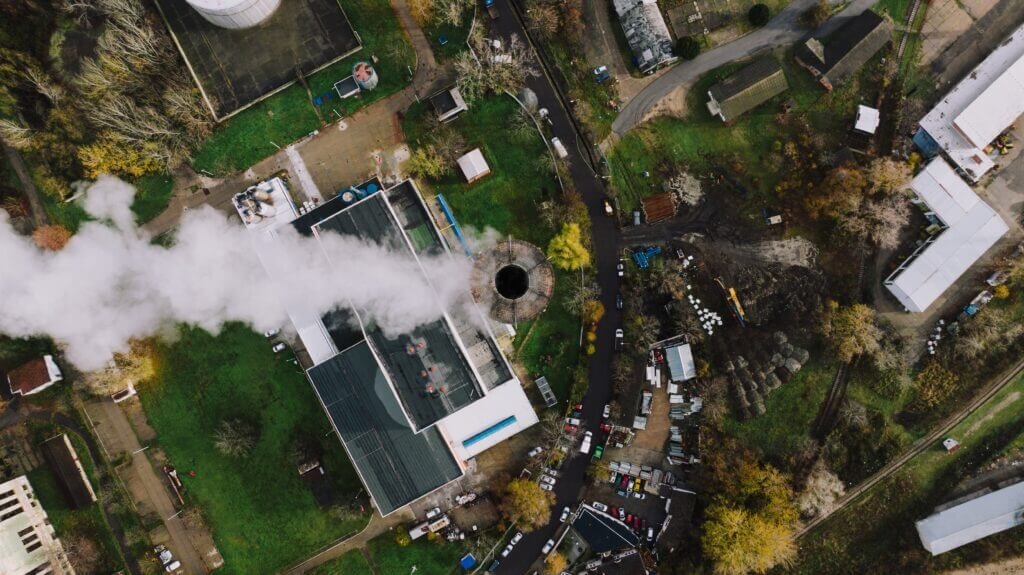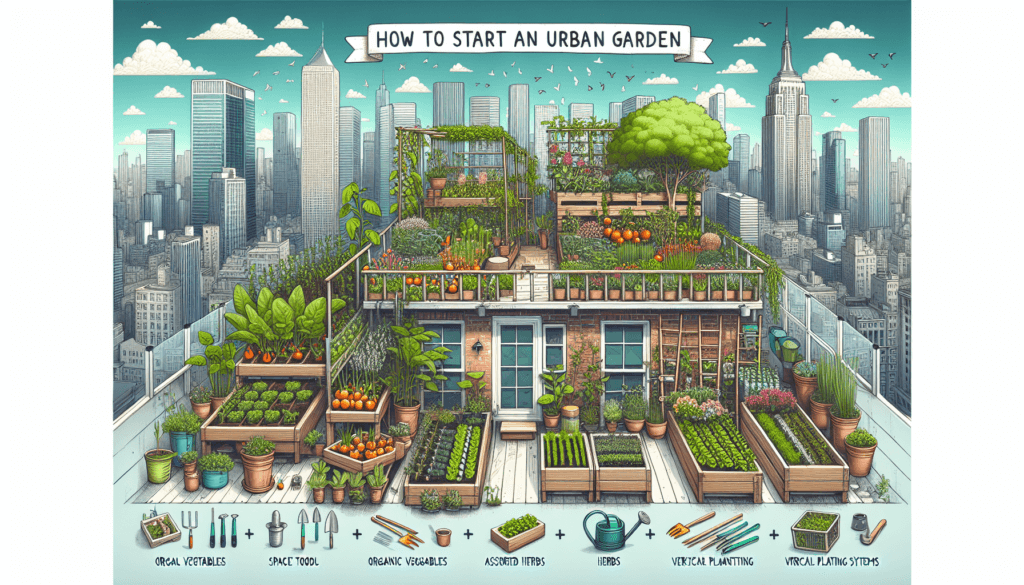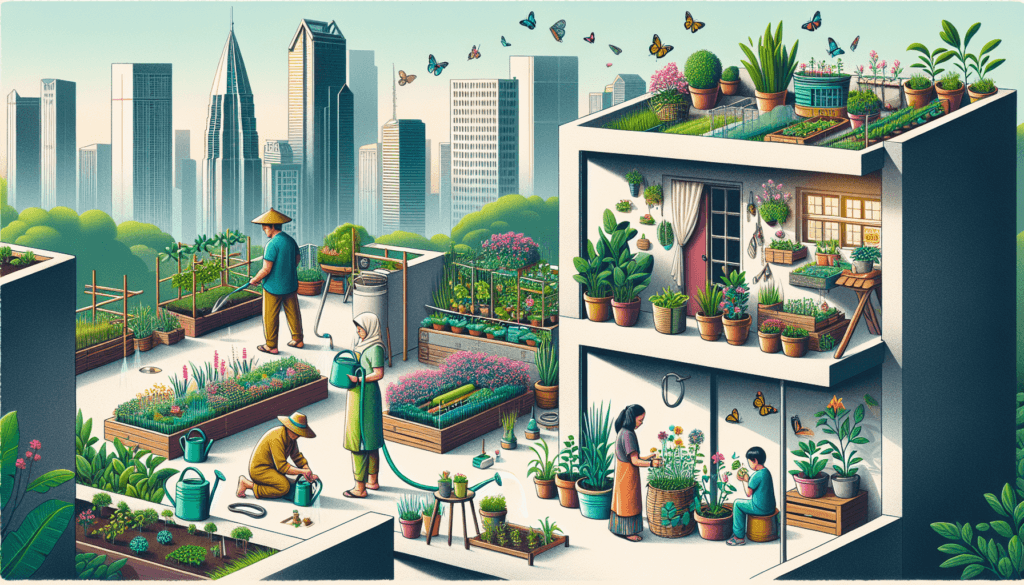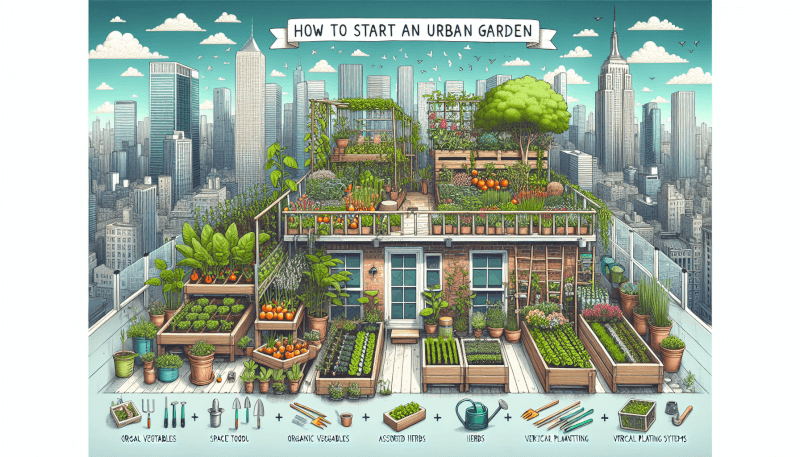Is it possible to have your own thriving garden even if you live in a small urban space? The answer is a resounding yes! In this article, we’ll guide you through the steps of starting an urban garden in a limited area, proving that lack of space is no longer a barrier to enjoying the wonders of gardening. Discover how to transform your balcony, patio, or even a windowsill into a green oasis brimming with fresh herbs, aromatic flowers, and vibrant vegetables. With a few simple tips and tricks, you’ll soon be reaping the rewards of your own urban garden, no matter how small.

Choosing the Right Plants
Evaluate Sunlight Exposure
When choosing plants for your urban garden, it is essential to evaluate the amount of sunlight your space receives. Some plants require full sun, while others can thrive in partial shade or even in indoor conditions. Take note of the sun’s movement throughout the day and identify areas in your garden that receive direct sunlight for at least six hours. This information will help you select plants that will thrive in your specific conditions.
Consider Plant Size
Since you have limited space in your urban garden, it’s crucial to consider the mature size of the plants you choose. Opting for compact and dwarf varieties or plants that can be trained to grow vertically will maximize your space. Keep in mind the potential height and spread of each plant to ensure they won’t overshadow or overcrowd each other.
Choose Low-Maintenance Plants
In a small urban garden, where space is limited, it’s advisable to choose plants that require minimal maintenance. Look for varieties that are known to be low-maintenance, disease-resistant, and drought-tolerant. These types of plants will help simplify your gardening tasks and ensure your garden thrives with minimal effort.
Opt for Container-Friendly Varieties
Container gardening is an excellent option for urban gardeners. Look for plants that are well-suited for containers, such as herbs, vegetables, and flowers. Ensure that the plants you choose have a compact growth habit and do not have extensive root systems. This way, you can successfully grow them in pots or other suitable containers, even in small spaces.
Select Plants Based on Your Tastes
Ultimately, the plants you choose for your urban garden should reflect your personal preferences and tastes. Consider what types of plants you enjoy and what purpose you want your garden to serve. Whether you desire a vibrant flower garden, a productive vegetable garden, or a mix of both, selecting plants that align with your preferences will ensure that you enjoy your garden to the fullest.
Planning and Designing Your Urban Garden
Measure Your Available Space
Before designing your urban garden, start by measuring the available space you have. Take note of any existing structures, pathways, or areas that are unsuitable for gardening. Knowing the dimensions of your space will help you create a garden layout that maximizes productivity and aesthetics.
Sketch a Layout
Once you have measured your available space, sketching a layout will provide a visual representation of your garden design. Consider the various elements you plan to include, such as raised beds, containers, pathways, and vertical structures. Keep in mind the sun exposure, accessibility, and the potential growth of the plants when arranging them in your layout.
Consider Vertical Gardening
Vertical gardening is an excellent technique to maximize space efficiency in a small urban garden. By utilizing walls, fences, or trellises, you can grow climbing plants, such as beans, peas, or cucumbers, vertically. This technique not only saves space on the ground but also adds visual interest to your garden.
Create Zones for Different Plants
Creating zones in your urban garden can help organize different types of plants and enhance both functionality and aesthetics. Consider grouping plants with similar light and water requirements together. For example, place shade-loving plants in one zone and sun-loving plants in another. This zoning will ensure that your plants receive the appropriate conditions for optimal growth.
Include Functional and Decorative Elements
To make your urban garden more enjoyable and practical, consider incorporating functional and decorative elements. Add seating areas, trellises, or arbors to create spaces for relaxation or dining. Consider using decorative elements such as sculptures or planters to add visual interest and personalize your garden. These elements will enhance the overall ambiance of your urban oasis.

Preparing the Small Space for Gardening
Clear the Area
Before starting your urban garden, clear the area of any obstructions, including weeds, debris, or unwanted vegetation. Remove any obstacles that may hinder the growth of your plants or interfere with your gardening activities. This step will provide a clean canvas for your garden and prevent competition between plants and unwanted vegetation.
Improve Soil Quality
Since the soil in urban environments may be compacted and lack essential nutrients, it is essential to improve its quality. Adding organic matter such as compost or well-rotted manure will enrich the soil, improve drainage, and provide essential nutrients for plant growth. Mix the organic matter into the existing soil thoroughly to create a fertile growing medium.
Consider Raised Beds or Containers
In small urban gardens, raised beds or containers provide an excellent solution for limited growing space. Raised beds offer better drainage, prevent soil compaction, and make it easier to control weeds. Containers, on the other hand, provide flexibility in terms of placement and allow you to garden in areas where soil quality may be poor. Consider using a combination of raised beds and containers to make the most of your small space.
Install Proper Drainage
Proper drainage is crucial for the health and well-being of your plants. In urban gardens, where space is limited, it’s essential to ensure that excess water can escape effectively. Consider adding drainage holes to containers or raised beds to prevent waterlogging. Additionally, if your garden is at ground level, you may need to improve drainage by amending the soil or creating a slight slope to facilitate water runoff.
Test Soil pH and Amend if Necessary
Testing the pH level of your soil is important, as it determines the availability of nutrients to your plants. Most plants prefer a slightly acidic to neutral pH range. If your soil is too acidic or alkaline, you can amend it by adding lime to raise the pH or elemental sulfur to lower it. By adjusting the soil pH to the appropriate range, you ensure that your plants can access the necessary nutrients for optimal growth.
Obtaining and Caring for Containers
Use Containers of Suitable Size and Material
Choosing the right containers for your urban garden is vital for the overall health and productivity of your plants. Select containers that are appropriate in size for the plants you intend to grow. Plants with extensive root systems may require larger containers to ensure healthy growth. Additionally, consider containers made from durable materials, such as plastic, terracotta, or fiberglass, that will withstand the elements and provide proper insulation.
Ensure Adequate Drainage in Containers
Proper drainage is crucial in container gardening to avoid waterlogged roots and promote healthy plant growth. Ensure that your containers have drainage holes at the bottom to allow excess water to escape. This will prevent water from stagnating and causing root rot. Using a layer of gravel or small rocks at the bottom of the container can promote drainage while still retaining moisture.
Consider Self-Watering Containers
Self-watering containers can be a practical solution, especially if you have a busy lifestyle or limited access to water. These containers have a reservoir that holds water, allowing the plants to draw moisture as needed. This feature can help maintain consistent moisture levels and prevent overwatering or underwatering. Consider using self-watering containers, particularly for plants that require a consistent moisture level.
Regularly Monitor Moisture Levels
Proper watering is essential for the health of your plants, especially in containers where water retention may vary. Regularly monitor the moisture levels in your containers by sticking your finger into the soil or using a moisture meter. Water the plants when the top inch of soil feels dry, ensuring that you do not overwater or underwater them. This practice will help maintain optimal growing conditions for your plants.
Inspect and Clean Containers Regularly
Inspecting and cleaning your containers regularly will help prevent the buildup of disease-causing organisms and ensure the longevity of your containers. After each growing season, empty the containers, remove any remaining roots or debris, and scrub them with a gentle detergent or a diluted bleach solution. Properly cleaning and maintaining your containers will provide a clean environment for your plants and reduce the risk of diseases.

Planting and Transplanting
Follow Planting Guidelines
When planting in your urban garden, it’s important to follow the specific planting guidelines for each plant. Take into account factors such as planting depth, spacing requirements, and companion planting recommendations. Proper planting techniques will ensure that your plants establish strong root systems and thrive in their new environment.
Start Seeds Indoors or Purchase Seedlings
For many plants, starting seeds indoors is a great way to get a head start on the growing season. This method allows you to control the germination process and protect seedlings from unfavorable weather conditions. Alternatively, you can purchase seedlings from local nurseries or garden centers. This option provides you with well-established plants that are ready to be transplanted into your urban garden.
Transplant Seedlings Carefully
When transplanting seedlings into your urban garden, handle them delicately to avoid damaging the roots. Dig a hole slightly larger than the root ball and ensure the seedlings are placed at the appropriate depth. Gently firm the soil around the roots and water the transplanted seedlings thoroughly. This careful transplanting process will help minimize transplant shock and promote healthy growth.
Space Plants Appropriately
Proper spacing between plants is crucial to prevent overcrowding and ensure optimal growth. Refer to the recommended spacing guidelines for each plant and provide enough room for air circulation and sunlight penetration. Proper spacing will also help prevent the spread of diseases and reduce competition for nutrients among neighboring plants.
Water Plants Gently After Transplanting
After transplanting your seedlings into the garden, it’s essential to water them thoroughly to promote root establishment. Use a gentle spray nozzle or a watering can to ensure the water reaches the roots without causing soil erosion. Watering immediately after transplanting will help settle the soil around the roots and reduce transplant shock.
Providing Proper Watering and Nutrients
Water Plants Regularly
Proper watering is crucial for the health and productivity of your urban garden. Plants require consistent moisture levels, especially during dry spells or hot weather. Regularly check the soil moisture levels and adjust your watering schedule accordingly. Aim to keep the soil consistently moist but not overly saturated.
Use Proper Watering Techniques
When watering your urban garden, it’s important to use proper techniques to ensure that the water effectively reaches the roots. Direct the water at the base of the plants, aiming for the soil rather than the leaves. This method prevents fungal diseases, minimizes water loss due to evaporation, and promotes deep root growth.
Consider Drip Irrigation Systems
Drip irrigation systems are an efficient and water-saving option for small-space urban gardens. These systems deliver water directly to the plants’ root zones through a network of tubes and emitters. Drip irrigation minimizes water waste by delivering water precisely where it’s needed, reducing evaporation and runoff. Consider installing a drip irrigation system in your urban garden to automate the watering process and ensure efficient water use.
Apply Fertilizers or Organic Amendments
To ensure that your plants receive the necessary nutrients, consider applying fertilizers or organic amendments regularly. Choose a fertilizer or amendment that is suitable for the types of plants you are growing and follow the recommended application rates. Organic options, such as compost or worm castings, are excellent choices as they promote soil health and enrich the soil with essential nutrients.
Use Mulch to Retain Moisture
Mulching is a beneficial practice in urban gardening as it helps retain moisture, control weeds, and regulate soil temperature. Apply a layer of organic mulch, such as wood chips or straw, around your plants to help retain moisture and prevent soil erosion. Mulch also adds organic matter to the soil as it breaks down, improving soil structure and fertility.

Managing Pests and Diseases
Monitor Plants for Signs of Pests
Vigilance is key when it comes to managing pests in your urban garden. Regularly inspect your plants for signs of pests, such as chewed leaves, holes, or sticky residue. Identify the pests causing the damage and choose appropriate pest control methods to minimize their impact on your garden.
Use Natural Pest Control Methods
In an urban garden, it’s preferable to use natural pest control methods to minimize the use of harsh chemicals. Encourage natural predators, such as ladybugs or lacewings, that feed on harmful pests. Additionally, practicing companion planting by growing pest-repellent plants alongside susceptible plants can deter pests. Introducing physical barriers, such as netting or row covers, can also provide protection against pests.
Apply Organic or Chemical Pesticides
If natural pest control methods are insufficient, you may need to resort to pesticides. Select organic pesticides that are specifically formulated for the pests in question and follow the recommended application rates. Always read and adhere to the instructions on the pesticide label. If necessary, consult with a local garden center or extension service for advice on safe and effective pesticide use.
Prevent Common Diseases
Disease prevention is crucial in maintaining a healthy urban garden. Provide adequate spacing between plants to allow for good air circulation, as this helps prevent the spread of diseases. Avoid overhead watering, as it can promote the growth of fungal diseases. Regularly remove any diseased plant material and dispose of it properly. These preventive measures will significantly reduce the risk of diseases affecting your garden.
Remove Affected Plants Immediately
If you notice any plants in your urban garden displaying signs of severe disease or pest infestation, it is essential to remove them immediately. Infected plants can quickly spread diseases, and heavily infested plants may not recover. Promptly removing affected plants will protect the rest of your garden from further damage and prevent the problem from spreading.
Optimizing Space and Maximizing Yield
Utilize Vertical Space Efficiently
In a small urban garden, utilizing vertical space is crucial to maximize yield. Train climbing plants to grow on trellises, walls, or fences to save valuable ground space. Additionally, utilize hanging baskets or vertical gardening systems to grow plants that can cascade downward, such as strawberries or trailing flowers. Vertical gardening not only provides more growing area but also adds visual interest to your garden.
Practice Succession Planting
Succession planting involves planting new crops as soon as a previous crop is harvested, allowing for continuous harvesting throughout the growing season. This method optimizes space by maximizing the productivity of each area and ensures a steady supply of fresh produce. Plan ahead and stagger your planting schedule to make the most efficient use of your small urban garden.
Consider Companion Planting
Companion planting is a practice where certain plants are grown together to provide mutual benefits. Some plants repel pests, while others attract beneficial insects or improve soil health. Consider companion planting in your urban garden to optimize space and foster a balanced and healthy ecosystem. Research compatible companion plants and take advantage of the benefits they offer.
Harvest Crops Continuously
To maximize yield and make the most of your urban garden, it’s important to harvest crops continuously. Regularly check for ripe fruits, vegetables, or herbs and harvest them promptly. Regular harvesting not only ensures the best flavor and quality but also stimulates further plant growth and encourages productivity.
Rotate Crops Regularly
Crop rotation is essential in small-space gardening to prevent the build-up of pests and diseases that can affect specific plant families. Moving plants from one bed or container to another can disrupt the life cycles of pests and reduce the risk of diseases spreading. Plan your crop rotations and avoid planting the same species or related plants in the same area year after year.

Maintaining and Pruning
Regularly Inspect and Maintain Plants
Maintaining healthy plants in your urban garden requires regular inspection and care. Inspect your plants regularly for signs of nutrient deficiency, pest infestations, or diseases. Remove any faded flowers, dead leaves, or damaged plant parts to promote plant health and overall aesthetics.
Prune and Trim Plants as Needed
Pruning and trimming plants are essential tasks in maintaining their shape, size, and overall health. Remove any dead or diseased branches, as they can serve as entry points for pests or diseases. Additionally, prune plants that have become overgrown or tangled to promote better air circulation and sun exposure. Use clean, sharp tools and follow proper pruning techniques to avoid damaging your plants.
Support Climbing Plants
Climbing plants, such as tomatoes or cucumbers, often require support to grow vertically and prevent them from sprawling on the ground. Use stakes, trellises, or cages to provide the necessary support for these plants. Regularly check the ties or clips holding the plants in place and adjust them as needed to prevent damage to the stems or branches.
Remove Weeds and Unwanted Seedlings
Weeds can quickly invade a small urban garden, stealing nutrients and water from your desired plants. Regularly inspect your garden for weeds and remove them promptly by hand pulling or using appropriate weeding tools. Additionally, remove any unwanted seedlings that may have sprouted in your garden to prevent them from competing with your desired plants.
Sterilize Tools to Prevent Disease Spread
To prevent the spread of diseases among your plants, it is crucial to sterilize your gardening tools regularly. Clean your tools with a detergent or a diluted bleach solution after each use to remove any traces of soil or plant debris. This practice ensures that you are not inadvertently transferring pathogens from one plant to another, promoting a healthy environment for your urban garden.
Enjoying the Fruits of Your Labor
Harvest Your Homegrown Produce
One of the most satisfying aspects of urban gardening is enjoying the fruits of your labor. Harvest your homegrown produce when it reaches peak ripeness, flavor, and size. Follow the specific harvesting guidelines for each plant to ensure you are picking the crops at the right time for optimal taste and quality.
Experiment with Recipes and Preserving
With an abundance of fresh produce from your urban garden, it’s the perfect opportunity to experiment with recipes and preserving techniques. Try new dishes, incorporate fresh herbs and vegetables into your cooking, or experiment with canning or freezing your surplus harvest. Enjoy the flavors of your homegrown produce all year round.
Share Surplus Produce with Neighbors
If you find yourself with a surplus of produce from your urban garden, consider sharing it with your neighbors or community. It’s a fantastic way to foster connections, build relationships, and spread the joy of homegrown food. Whether you give them a basket of freshly picked vegetables or swap produce with fellow urban gardeners, sharing the fruits of your labor adds an extra level of fulfillment to your gardening experience.
Document Your Urban Garden Journey
Throughout your urban gardening journey, consider documenting your progress and experiences. Take photographs, keep a journal, or start a blog to chronicle the growth and development of your plants. Not only will this serve as a record of your hard work, but it can also inspire and motivate others who are interested in starting their own urban garden.
Find Community Urban Gardening Events
To further enrich your urban gardening experience, seek out community events related to gardening. Look for workshops, plant swaps, or farmers’ markets in your area. Engaging with fellow urban gardeners and local gardening organizations can provide valuable knowledge, inspiration, and the opportunity to connect with like-minded individuals.
Starting an urban garden in a small space may initially seem challenging, but with careful planning and a bit of creativity, it can be a rewarding and fulfilling endeavor. By choosing the right plants, designing an efficient layout, preparing the space properly, providing the necessary care, and enjoying the fruits of your labor, you can create a thriving urban garden that brings both beauty and sustenance to your surroundings. So roll up your sleeves, unleash your green thumb, and let your urban garden flourish!


